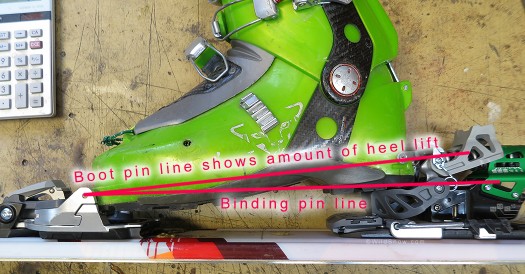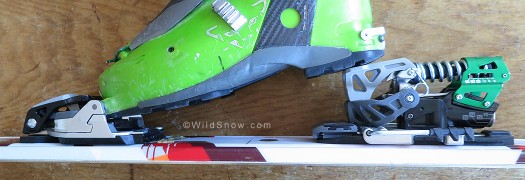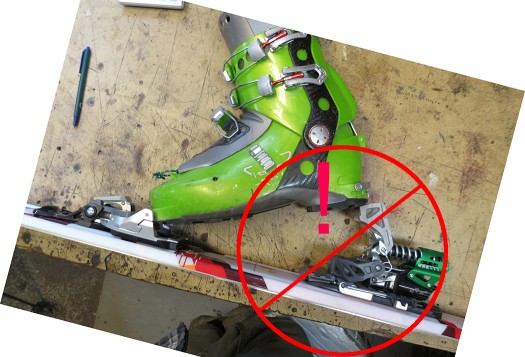Beast 16 backcountry skiing binding heel lifters give you average height for climbing, but the bottom one also acts as the brake retractor. In our view, this is one of the most ingenious aspects of the Beast. Video below does a better job of explaining; in writing I’d say that you simply flip down the low lift when you’re switching to touring mode (yes, you have to exit binding to switch modes), snap your toe back into the front binding unit, then stomp down firmly with your heel. As your heel goes down the binding rear unit slides backwards and the brake folds up. Reminds me of one of those “Transformer” movies. How this will work with snow and ice involved is for the jury to decide.

Dynafit Beast lower heel lift position while touring, not flat on the ski but not much lift either. Could be useful but we'd like another height option between lowest and highest. Note that the reason the heel can't be any lower is that unlike other tech bindings, Beast heel unit and pins do not rotate out of the way when you're in touring mode. Thus, the boot heel still has to rest above the pins for lowest touring position. Interestingly, if you did remove the brake from Beast, the heel unit does rotate out of the way and stick at 90 degrees, producing a very low heel position.
In terms of comparison, Beast high-lift and that of Radical model are roughly equivalent. Heel of boot in Radical is about 5 mm higher than a boot in the Beast. Once you were used to either binding you’d probably be happy, but coming from a Radical to Beast you would perhaps notice the difference.
It’s sometimes confusing what you get in terms of the lower lift positions on tech bindings. Main thing to know is (in this model iteration, anway): Beast only has one lower lift position, which places your heel 4 mm higher than your toe — essentially a heel-flat-on-ski mode though it could be flatter. In my original Beast intro video I mistakenly said the binding did not have much of a heel-flat-on-ski mode, when it actually does. Dynafit Radical has two lower lift positions: medium lifter places your heel 19 mm above your toe, and you can go one step down from there to a flat-heel mode.
It bears repeating that that the reason Beast doesn’t have a lower heel position for touring is that the heel unit doesn’t rotate like other tech bindings, thus the pins stay oriented forward and the boot has to rest above the pins for touring.

Heel lift in highest position on Beast ski binding. The binding is configured to this mode by simply flipping the grey plastic arm to a forward position.

This lift position is tempting and worked with our prototype, but it's not correct and could be damaged in this configuration. We'd guess that retail binding version will eliminate the ability to stand the lift up under your boot as pictured.
I’ll be moving some of this today over to Page 2 of our Dynafit Beast 16 Review FAQ.
WildSnow.com publisher emeritus and founder Lou (Louis Dawson) has a 50+ years career in climbing, backcountry skiing and ski mountaineering. He was the first person in history to ski down all 54 Colorado 14,000-foot peaks, has authored numerous books about about backcountry skiing, and has skied from the summit of Denali in Alaska, North America’s highest mountain.
